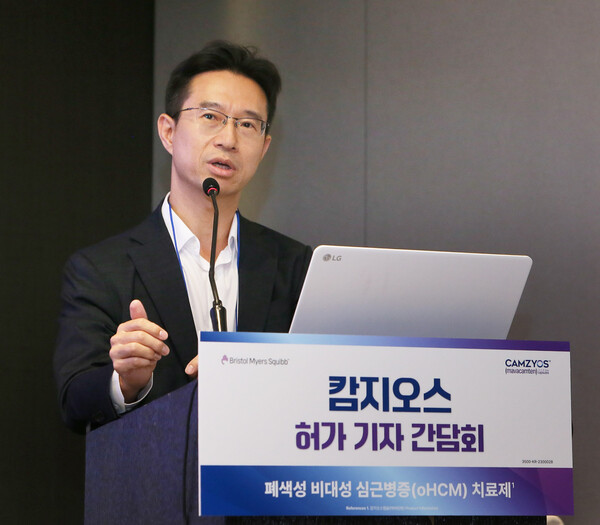Bristol Myers Squibb (BMS) Korea held a press conference on Monday to celebrate the approval of Camzyos, an obstructive hypertrophic cardiomyopathy (oHCM) treatment, and highlight the clinical value of the EXPLORER-HCM trial, which led to the drug's approval.
Camzyos is a treatment that selectively inhibits the excessive cross-linking of cardiac myosin and actin, which is responsible for the development of oHCM, which is a rare and potentially fatal heart disease in which thickened left ventricular muscle blocks blood flow to the rest of the body, causing symptoms ranging from shortness of breath to heart failure, syncope, and sudden death.
On May 24, the Ministry of Food and Drug Safety approved Camzyos for the treatment of patients with symptomatic oHCM to improve exercise function and symptoms.

During the presentation, Professor Kim Hyung-kwan of the Department of Cardiology at Seoul National University Hospital, provided an overview of HCM in Korea, the treatment landscape, and the unmet needs in current treatment strategies.
"In the myocardium, two proteins, actin and myosin, are linked together to contract the heart and then separate afterward to relax the myocardium, thus acting as a pump, which is the heart's function," Kim said. "However, in patients with HCM, actin and myosin are overly linked, causing the myocardium to contract excessively, and this over-linking makes it difficult for the myocardium to relax."
According to Kim, HCM is one of the leading causes of sudden cardiac death in young people and is no longer a rare disease as its prevalence in Korea is gradually increasing with the widespread use of echocardiography.
Kim explained that HCM patients are at high risk of developing related complications and death, especially young HCM patients, whose mortality rate is more than four times higher than that of the general population.
"Notably, while HCM has two categories -- obstructive and non-obstructive --, 15-20 percent of all HCM patients are obstructive, and the treatment for oHCM has been very limited, which is unfortunate," he said. "Until now, treatments for oHCM have focused on symptomatic relief and prevention of complications, rather than addressing the underlying cause."
Some of the commonly used beta-blockers and calcium channel blockers were not designed to address the pathophysiology of HCM, so it was difficult to expect long-term symptom improvement and their effectiveness was not as good as expected, he added.
If the effectiveness of these drug treatments is poor, Kim said that surgical septal myectomy or alcohol septal ablation is possible.
"However, these two treatments are not without their own risks and can only be maximally effective when performed by experienced specialists," Kim said.
With such limited options, Kim highly praised the approval of Camzyos in Korea, stressing that the advent of this innovative therapy has opened up a new landscape for the treatment of oHCM.
"Camzyos is a new class of therapies that directly targets the excessive binding of actin-myosin, the underlying cause of oHCM," he said. "By reducing the number of excessive cross-links between actin and myosin, Camzyos improves left ventricular outflow tract obstruction and normalizes excessive cardiac contraction and by restoring left ventricular relaxation, reducing ventricular filling pressures, and improving myocardial energy overconsumption, it has been shown to significantly improve prognosis and symptoms of oHCM."
During the press conference, BMS Korea Executive Vice President of Medical Affairs Kim Hyun-ho also commented on the clinical value the EXPLORER-HCM clinical trial, which led to Camzyos' approval.
EXPLORER-HCM is a Phase 3 clinical trial to determine the efficacy of Camzyos in patients with symptomatic oHCM. In EXPLORER-HCM, the Camzyosarm achieved statistically significant improvements in heart function and exercise capacity compared to the placebo.
The primary endpoints were maintenance or improvement in New York Heart Association class (NYHA class) and improvement in peak oxygen consumption (pVO2).
"In the EXPLORER-HCM study, Camzyos demonstrated a significant treatment effect in patients with oHCM as the improvement in New York Heart Association class (NYHA class) and improvement in peak oxygen consumption (pVO2) in patients with oHCM, which was the primary endpoint, was more than double that of the placebo at week 30," the BMS medical director said.
In addition, patients treated with Camzyos experienced a more than fourfold reduction in left ventricular outflow tract (LVOT) obstruction after exercise, and seven out of 10 patients treated also experienced an improvement in LVOT obstruction after exercise to the point where surgery was not considered, with consistent benefits over 30 weeks, he added.
Related articles
- BMS Korea wins insurance coverage for myelofibrosis drug Inrebic
- BMS Korea scores nod for rare oHCM heart disease treatment
- Why is BMS myeloma drug Abecma’s introduction delayed?
- ‘BMS’ Reblozyl to ease blood transfusion burden for MDS-RS patients’
- BMS Onureg bags insurance coverage in Korea for AML patients
- BMS’ Sotyktu scores nod for plaque psoriasis patients
- 'Joint reimbursement of Opdivo, CDx platform marks milestone in gastric cancer but challenges remain'

